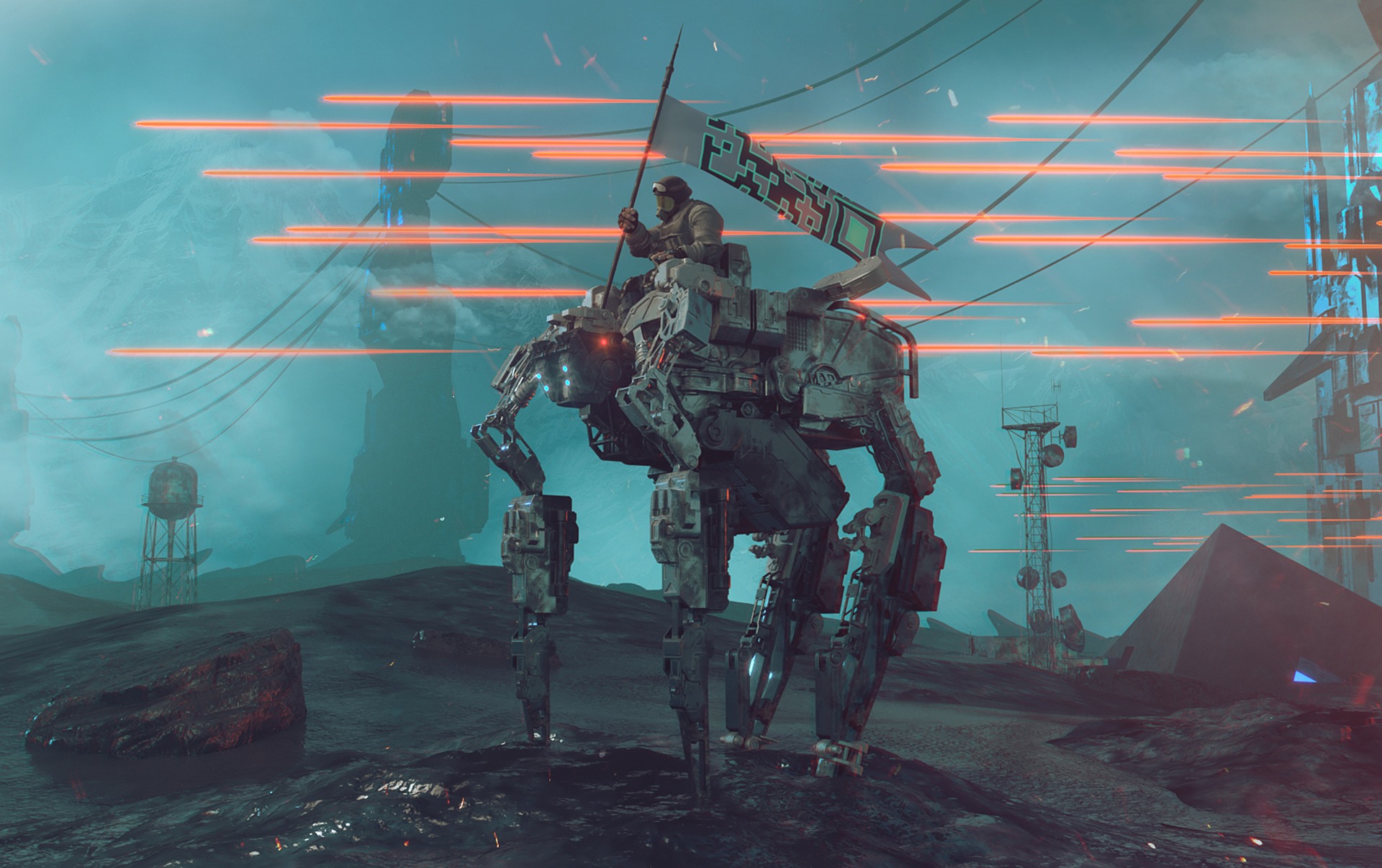Originally published at Serious Wonder
INTRODUCTION
Want to imagine the soldier of the future? A look at video game super-soldiers gives you an ideal glimpse of the desired improvements.
As a US Army military veteran and a longtime gamer, I can attest that while being a soldier and playing one in a video game are very different experiences, there exist several functional overlaps in the goals and tools provided to achieve objectives.
For example, examine the differences and similarities between playing basic training in a game like America’s Army, and enduring an actual enlistment. America’s Army is designed to teach prospective soldiers what to expect both in training and actual combat. While the game version does not nearly prepare a player for the physical and psychological demands of actual basic training and participating in what Army operations entail, it does give an understanding of the objectives one would be expected to accomplish while in service and some of tools available to achieve those goals.
The military uses the concept of force multipliers: tools that enable a single military resource, a soldier for example, to multiply its power for greater domination of the battlespace. A soldier with a gun can dominate more space than one with a spear. A unit with fast vehicles can dominate more terrain than a unit on foot, and so on. Better force multipliers have been the objective of military strategists throughout history, and video games provide an imaginative look at proposed multipliers. As the realism of games improve so too does the real-world equivalents of those imagined multipliers.
Aside from video games, another medium that depicts idealized soldiers would be movies, typically action and science fiction varieties. Plenty of films have provided stories of single protagonists taking on overwhelming odds and winning; however, movies fall short as a satisfying analogy on a key aspect: information delivery. A game must feed you the information required to complete your mission in a readily available manner, a process largely invisible and unsystematic in movies. A movie can justify any number of lucky streaks for the protagonist or bad tactics on the enemy’s behalf, simply to create a more entertaining story, but a video game must provide you the tools to accomplish your goals with your own actions and understanding. Then what are the qualities a video game hero possesses to allow the player to become an unstoppable force? What are the force multipliers given to a video game player to allow them to become a one-person army?
THE SOLDIER – FATIGUE AND HEALING
Starting from the most obvious, there is armor and weaponry, but that bypasses the more basic requirements of preventing fatigue and injury. One of the first major trials to overcome in basic training is the physical training itself: an intense process designed to quickly turn untrained individuals into soldiers physically capable of carrying a combat load and marching from one battlefield to another. It takes a heavy toll and even those that seem to pass basic training unscathed will often suffer later injuries as the training continues throughout their career. The ideal soldier must be able to move quickly without suffering fatigue or injury. Excluding a sprint limiting mechanism to prevent running forever, you can still jog, jump, and fight all while carrying huge loads of equipment, weapons, and ammunition with barely a drop in speed in most games.
This leads to the most important advantage over reality you see occur in gaming. Lack of fatigue. Several older video games had the player crossing hundreds of miles over the course of the game (e.g. Elder Scrolls: Arena’s map was over 6 million square miles) and while modern games have had to shrink the available world environments to economically produce their higher resolution content (Elder Scrolls: Skyrim was only 14.3 square miles), they still have the player crossing dozens of miles of harsh terrain without diminished speed or suffering stress injuries. Even if they are injured, most injuries, even life-threatening ones, can be healed, usually in seconds. The mechanism varies from game to game, but most use a form of readily available chemical or energy packages that can be consumed quickly and heal the player without the need to even stop and rest. Should resting be an available option, the player is able to repair almost any amount of injury overnight. The amount of sustainable injuries a player can accumulate without a reduction in combat effectiveness is most impressive as well. Even without armoring, players can usually absorb repeated wounds and approach near death before there is any perceptible dip in perceptions, capabilities, or combat effectiveness. Heavy trauma does not even lead to shock to threaten the player.
So, your average character is an incredibly fit, incredibly strong individual with great mental discipline, able to ignore pain and override the body’s natural responses to injuries, with access to medical technology that would violate our current understanding of thermodynamics.
Ignoring the instant healing, as some calculations of the energy required for such a feat in a portable package put it beyond our foreseeable technologies, several new technologies are being developed to improve injury survivability through rapid sealing of the wounds within the body rather than bandaging the outside. Newer combat bandaging is designed to enter the wound to stop internal hemorrhaging before it can incapacitate the soldier. Other research is focusing on improving soldier endurance and carrying capacity through the use of exoskeletons and robotic followers.
COMBAT SUPPORT DRONES
With these basics we now have a soldier, probably with a robotic mule companion, that can armor up with a full combat load and move swiftly and quietly into enemy territory. Boston Dynamics has consistently shown improvement.
Once they get into enemy territory comes the next great force multiplier usually given to players: The ability to keep fighting by gathering more useful combat supplies off the enemies themselves. Every soldier would prefer to keep using their own personal weapon which they have trained on and sighted for accuracy themselves, but even with larger combat loads and a carrying companion the normal soldier would quickly run out of ammo facing the average video game enemy force, and if we are to imagine replicating those digital feats, our soldier will need the ability to quickly scavenge and use the enemy’s weapons and ammunition. Weapons training teaches a soldier familiarity with enemy weapons, but if they had ready access to a database of weapons maintenance and operations that would be of great use in prolonged conflicts.
Use of Augmented Reality (AR) technologies to relay this information to the soldier quickly, allowing them to pick up a new weapon, understand it’s operation and troubleshooting, would replicate the abilities most video game protagonists have to pick up any weapon and immediately begin using it. Add in a wireless sight shot tracking system and the AR display might be able to correct a soldier’s accuracy on the fly by calculating the weapon’s firing deviation and altering the heads-up targeting display. A form of aim assist for real life. Perhaps our robot helper could even scavenge after conflicts and refill ammo magazines for their soldier giving them the equivalent of a video game loot collection bot.
TACTICAL DATA
Next, successful fighting against a numerically superior enemy requires more than just endurance, armor, and ammo. It requires strategic dominance as well.
Many games provide the player with an invaluable tool in the all-seeing map. This mechanism not only tells the player where they are in relation to their targets but also where enemy forces are located. Such depth of intelligence is almost never available to soldiers in the field; the best guesses must be given at pre-mission briefings with little chance beyond radio calls to update the information as the mission proceeds. This is almost never the case in video games. If you have no starting map, it usually auto builds as you move. The map shows not only what is in your field of vision but also around obstacles and the other side of walls.
All this superior tactical data being built is useless unless it can be relayed to the soldier in a usable fashion. This is where video games really start to shine. With the screen being the primary feedback interface, the design of the user’s display becomes of critical importance. Taking their cue from aviation heads-up displays (HUD), user interfaces were designed to quickly give all relevant data required to survive the game to the user. This is usually a transparent overlay displayed over the player’s field of vision often with contextual popups as new items or threats appear. These displays include the aforementioned mapping system to know where they are, status bar to know what they have available, and possibly most important for a soldier in a fire fight, directional indicators of enemy lines of attack.
One the first things a soldier can tell you they need if lost in combat is a full sense of the field around you and where the enemy might be coming from. One gets tunnel vision and can’t track possible side or rear attacks if they are focused on movement in front of them. A HUD bringing the soldier’s attention to incoming threats and possible strategic responses can go a long way to improving their survivability.
PUTTING IT ALL TOGETHER
With all this in line we can imagine a soldier entering the field moving quickly over varied terrain, their exosuit carrying the load of their heavy armor and weaponry. They are a ‘walking tank’ capable of surviving a direct firefight should the need arise. Following behind them a mobile robotic mule platform stops and launches an airplane drone that sails up high above the target space beyond the reach of ground fire. Flying over, it begins building a tactical map of terrain and heat signatures while smart software makes estimates at combatant threat levels. Three more micro-copter drones deploy and speed stealthily into the space to confirm and update the combatant threat profiles. All this data feeds back to the soldier’s AR display who reviews the threats and begins moving into position to take out the outer-most threats as quietly as possible, then on the larger group of threats.
Once they are dealt with the assault can no longer be hidden. The mini-copter drones move to an overwatch position around the soldier’s location in a zig-zag pattern to warn of incoming attacks. The soldier stops and reviews the map, then marks the possible exits of the target building. Two armed ground drones dart from the mule and take position, following orders to lay suppressing fire on any movement. The soldier moves to a window while signaling for another small tracked drone to make its way to a nearby door they marked on their map. The drone takes position on the door while the soldier throws a camera ball through the window. As the ball rolls into the room the drone on the door explodes bringing the combatant’s attention to the door. The soldier quickly reviews the updated target map the ball has built and fires into the window flanking the targets inside. They walk through the opened door and order one of the mini-copter drones to begin a search pattern. It begins a randomized search of the interior while building up a map and marking the location of the suspect objective. The soldier moves to the objective and gathers it up. They take it back outside and load it on the mule, moving out quickly, drones returning automatically before the incoming enemy re-reinforcements spotted from above can arrive.
CONCLUSION
With higher effective endurance, local robotic support, and fast and adaptive tactical data feeds, the future soldier can get in and out fast with minimal exposure to danger, giving us far more effective, tactically precise, military capabilities. This is the realized potential suggested by video games in their attempt to convey the power fantasy of a lone warrior against incredible odds. Physically and mentally unbreakable, with abundant locally available support, and the tactical intelligence to surmount any enemy. This is the scenario presented in almost any action video game, and as technology advances this seemly impossible scenario will be made reality.







